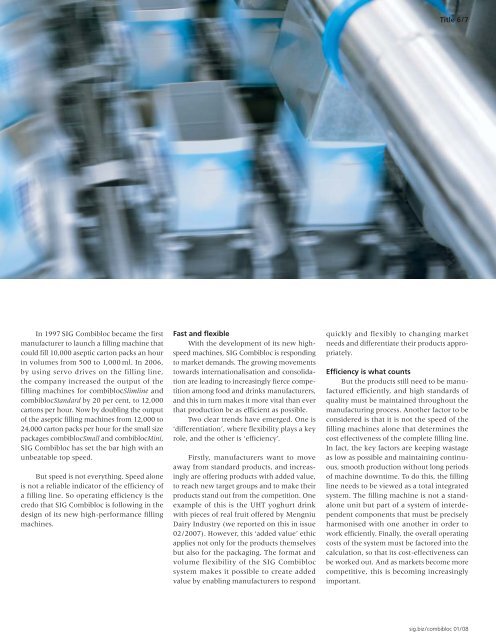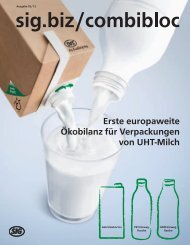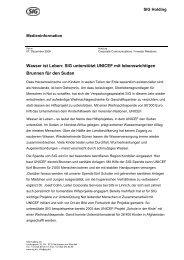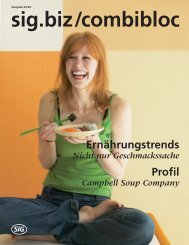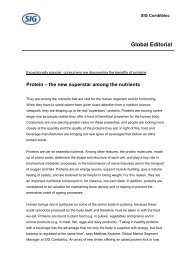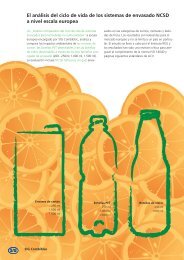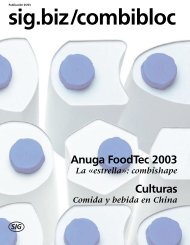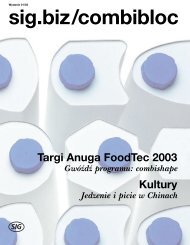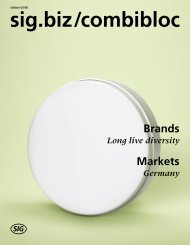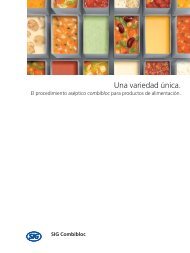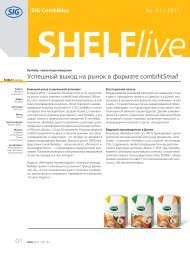English - SIG Combibloc
English - SIG Combibloc
English - SIG Combibloc
Create successful ePaper yourself
Turn your PDF publications into a flip-book with our unique Google optimized e-Paper software.
In 1997 <strong>SIG</strong> <strong>Combibloc</strong> became the first<br />
manufacturer to launch a filling machine that<br />
could fill 10,000 aseptic carton packs an hour<br />
in volumes from 500 to 1,000 ml. In 2006,<br />
by using servo drives on the filling line,<br />
the company increased the output of the<br />
filling machines for combiblocSlimline and<br />
combiblocStandard by 20 per cent, to 12,000<br />
cartons per hour. Now by doubling the output<br />
of the aseptic filling machines from 12,000 to<br />
24,000 carton packs per hour for the small size<br />
packages combiblocSmall and combiblocMini,<br />
<strong>SIG</strong> <strong>Combibloc</strong> has set the bar high with an<br />
unbeatable top speed.<br />
But speed is not everything. Speed alone<br />
is not a reliable indicator of the efficiency of<br />
a filling line. So operating efficiency is the<br />
credo that <strong>SIG</strong> <strong>Combibloc</strong> is following in the<br />
design of its new high-performance filling<br />
machines.<br />
Fast and flexible<br />
With the development of its new highspeed<br />
machines, <strong>SIG</strong> <strong>Combibloc</strong> is responding<br />
to market demands. The growing movements<br />
towards internationalisation and consolidation<br />
are leading to increasingly fierce competition<br />
among food and drinks manufacturers,<br />
and this in turn makes it more vital than ever<br />
that production be as efficient as possible.<br />
Two clear trends have emerged. One is<br />
‘differentiation’, where flexibility plays a key<br />
role, and the other is ‘efficiency’.<br />
Firstly, manufacturers want to move<br />
away from standard products, and increasingly<br />
are offering products with added value,<br />
to reach new target groups and to make their<br />
products stand out from the competition. One<br />
example of this is the UHT yoghurt drink<br />
with pieces of real fruit offered by Mengniu<br />
Dairy Industry (we reported on this in issue<br />
02/2007). However, this ‘added value’ ethic<br />
applies not only for the products themselves<br />
but also for the packaging. The format and<br />
volume flexibility of the <strong>SIG</strong> <strong>Combibloc</strong><br />
system makes it possible to create added<br />
value by enabling manufacturers to respond<br />
Title 6/7<br />
quickly and flexibly to changing market<br />
needs and differentiate their products appropriately.<br />
Efficiency is what counts<br />
But the products still need to be manufactured<br />
efficiently, and high standards of<br />
quality must be maintained throughout the<br />
manufacturing process. Another factor to be<br />
considered is that it is not the speed of the<br />
filling machines alone that determines the<br />
cost effectiveness of the complete filling line.<br />
In fact, the key factors are keeping wastage<br />
as low as possible and maintaining continuous,<br />
smooth production without long periods<br />
of machine downtime. To do this, the filling<br />
line needs to be viewed as a total integrated<br />
system. The filling machine is not a standalone<br />
unit but part of a system of interdependent<br />
components that must be precisely<br />
harmonised with one another in order to<br />
work efficiently. Finally, the overall operating<br />
costs of the system must be factored into the<br />
calculation, so that its cost-effectiveness can<br />
be worked out. And as markets become more<br />
competitive, this is becoming increasingly<br />
important.<br />
sig.biz/combibloc 01/ 08


